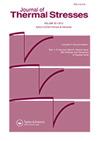基于拉丁超立方采样和坐标旋转法的热分析模型校正方法
IF 2.3
3区 工程技术
Q2 MECHANICS
引用次数: 0
摘要
摘要为了准确预测航天器在轨温度,提出了一种结合拉丁超立方体采样和坐标旋转法的热分析模型校正方法。首先,确定需要修正的热设计参数。其次,采用拉丁超立方体采样方法对热设计参数进行采样,并将采样结果输入i - ideas /TMG软件进行热模拟计算。然后根据热模拟结果,利用Spearman秩相关系数公式将热设计参数分为全局敏感参数、局部敏感参数和不敏感参数。最后,根据分层校正思想,利用坐标旋转法对上述参数进行校正,求出满足目标函数的最优解。校正后,各测温点的热模拟与热平衡测试的最大温差在高温工况下小于1℃,在低温工况下最大温差小于2℃。本文章由计算机程序翻译,如有差异,请以英文原文为准。
Thermal analysis model correction method based on Latin hypercube sampling and coordinate rotation method
Abstract To predict on-orbit temperatures of the spacecraft accurately, a correction method for the thermal analysis model is proposed that combines Latin hypercube sampling and the coordinate rotation method. First, the thermal design parameters to be corrected are determined. Second, the thermal design parameters are sampled by the Latin hypercube sampling, and the sampling results inputted to the I-deas/TMG software for the thermal simulation calculation. Then according to the results of thermal simulation, the thermal design parameters are classified using the Spearman rank correlation coefficient formula, as either global sensitive parameters, local sensitive parameters, or insensitive parameters. Finally, according to the layered correction idea, the above parameters are corrected by the coordinate rotation method to find the optimal solution that satisfies the objective function. After the correction, the maximum temperature difference between the thermal simulation and the thermal balance test for each temperature measurement point is less than 1 °C for high-temperature conditions, and a maximum temperature difference of less than 2 °C for low-temperature condition.
求助全文
通过发布文献求助,成功后即可免费获取论文全文。
去求助
来源期刊

Journal of Thermal Stresses
工程技术-力学
CiteScore
5.20
自引率
7.10%
发文量
58
审稿时长
3 months
期刊介绍:
The first international journal devoted exclusively to the subject, Journal of Thermal Stresses publishes refereed articles on the theoretical and industrial applications of thermal stresses. Intended as a forum for those engaged in analytic as well as experimental research, this monthly journal includes papers on mathematical and practical applications. Emphasis is placed on new developments in thermoelasticity, thermoplasticity, and theory and applications of thermal stresses. Papers on experimental methods and on numerical methods, including finite element methods, are also published.
 求助内容:
求助内容: 应助结果提醒方式:
应助结果提醒方式:


